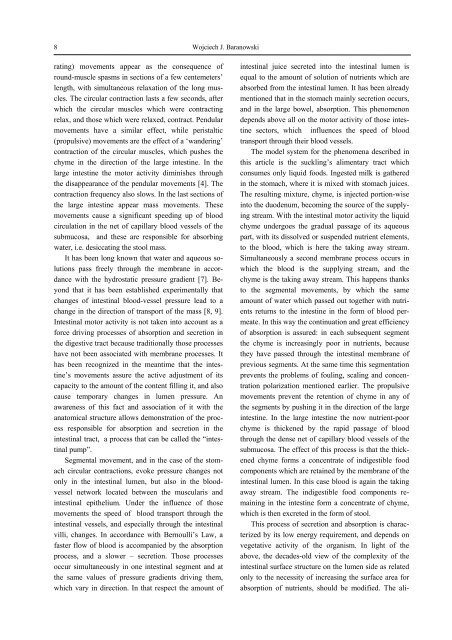medical and biological sciences - Collegium Medicum - Uniwersytet ...
medical and biological sciences - Collegium Medicum - Uniwersytet ...
medical and biological sciences - Collegium Medicum - Uniwersytet ...
You also want an ePaper? Increase the reach of your titles
YUMPU automatically turns print PDFs into web optimized ePapers that Google loves.
8Wojciech J. Baranowskirating) movements appear as the consequence ofround-muscle spasms in sections of a few centemeters’length, with simultaneous relaxation of the long muscles.The circular contraction lasts a few seconds, afterwhich the circular muscles which were contractingrelax, <strong>and</strong> those which were relaxed, contract. Pendularmovements have a similar effect, while peristaltic(propulsive) movements are the effect of a ‘w<strong>and</strong>ering’contraction of the circular muscles, which pushes thechyme in the direction of the large intestine. In thelarge intestine the motor activity diminishes throughthe disappearance of the pendular movements [4]. Thecontraction frequency also slows. In the last sections ofthe large intestine appear mass movements. Thesemovements cause a significant speeding up of bloodcirculation in the net of capillary blood vessels of thesubmucosa, <strong>and</strong> these are responsible for absorbingwater, i.e. desiccating the stool mass.It has been long known that water <strong>and</strong> aqueous solutionspass freely through the membrane in accordancewith the hydrostatic pressure gradient [7]. Beyondthat it has been established experimentally thatchanges of intestinal blood-vessel pressure lead to achange in the direction of transport of the mass [8, 9].Intestinal motor activity is not taken into account as aforce driving processes of absorption <strong>and</strong> secretion inthe digestive tract because traditionally those processeshave not been associated with membrane processes. Ithas been recognized in the meantime that the intestine’smovements assure the active adjustment of itscapacity to the amount of the content filling it, <strong>and</strong> alsocause temporary changes in lumen pressure. Anawareness of this fact <strong>and</strong> association of it with theanatomical structure allows demonstration of the processresponsible for absorption <strong>and</strong> secretion in theintestinal tract, a process that can be called the “intestinalpump”.Segmental movement, <strong>and</strong> in the case of the stomachcircular contractions, evoke pressure changes notonly in the intestinal lumen, but also in the bloodvesselnetwork located between the muscularis <strong>and</strong>intestinal epithelium. Under the influence of thosemovements the speed of blood transport through theintestinal vessels, <strong>and</strong> especially through the intestinalvilli, changes. In accordance with Bernoulli’s Law, afaster flow of blood is accompanied by the absorptionprocess, <strong>and</strong> a slower – secretion. Those processesoccur simultaneously in one intestinal segment <strong>and</strong> atthe same values of pressure gradients driving them,which vary in direction. In that respect the amount ofintestinal juice secreted into the intestinal lumen isequal to the amount of solution of nutrients which areabsorbed from the intestinal lumen. It has been alreadymentioned that in the stomach mainly secretion occurs,<strong>and</strong> in the large bowel, absorption. This phenomenondepends above all on the motor activity of those intestinesectors, which influences the speed of bloodtransport through their blood vessels.The model system for the phenomena described inthis article is the suckling’s alimentary tract whichconsumes only liquid foods. Ingested milk is gatheredin the stomach, where it is mixed with stomach juices.The resulting mixture, chyme, is injected portion-wiseinto the duodenum, becoming the source of the supplyingstream. With the intestinal motor activity the liquidchyme undergoes the gradual passage of its aqueouspart, with its dissolved or suspended nutrient elements,to the blood, which is here the taking away stream.Simultaneously a second membrane process occurs inwhich the blood is the supplying stream, <strong>and</strong> thechyme is the taking away stream. This happens thanksto the segmental movements, by which the sameamount of water which passed out together with nutrientsreturns to the intestine in the form of blood permeate.In this way the continuation <strong>and</strong> great efficiencyof absorption is assured: in each subsequent segmentthe chyme is increasingly poor in nutrients, becausethey have passed through the intestinal membrane ofprevious segments. At the same time this segmentationprevents the problems of fouling, scaling <strong>and</strong> concentrationpolarization mentioned earlier. The propulsivemovements prevent the retention of chyme in any ofthe segments by pushing it in the direction of the largeintestine. In the large intestine the now nutrient-poorchyme is thickened by the rapid passage of bloodthrough the dense net of capillary blood vessels of thesubmucosa. The effect of this process is that the thickenedchyme forms a concentrate of indigestible foodcomponents which are retained by the membrane of theintestinal lumen. In this case blood is again the takingaway stream. The indigestible food components remainingin the intestine form a concentrate of chyme,which is then excreted in the form of stool.This process of secretion <strong>and</strong> absorption is characterizedby its low energy requirement, <strong>and</strong> depends onvegetative activity of the organism. In light of theabove, the decades-old view of the complexity of theintestinal surface structure on the lumen side as relatedonly to the necessity of increasing the surface area forabsorption of nutrients, should be modified. The ali-
















